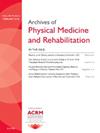Individualized Versus General Exercise Therapy in People With Subacromial Pain Syndrome: A Randomized Controlled Trial
IF 3.6
2区 医学
Q1 REHABILITATION
Archives of physical medicine and rehabilitation
Pub Date : 2025-01-01
DOI:10.1016/j.apmr.2024.08.027
引用次数: 0
Abstract
Objective
To evaluate the effect of individualized exercises based on movement fault (MF) control on pain intensity, and disability in subjects with chronic subacromial pain syndrome (SAPS).
Design
Randomized controlled trial.
Setting
Rehabilitation clinics.
Participants
Thirty-eight participants with chronic SAPS (mean [SD] age, 52.23 (8.47); 60 % women).
Interventions
The participants were randomly allocated to 1 of the intervention groups (individualized exercises based on MFs control test designed to target specific movement faults) or the control group (commonly prescribed general scapular stabilization exercises). Both groups received exercise sessions twice a week for 4 weeks.
Main Outcome Measures
The primary outcome measures were pain intensity at rest (PR) and during arm raising (PAR) using a visual analog scale. Disability was assessed as a key secondary outcome, including the disabilities of the arm, shoulder, and hand (DASH) questionnaire and the Shoulder Pain and Disability Index (SPADI).
Results
Following completion of all exercise sessions, PAR was significantly lower in the intervention group compared to the control group (mean, 9.17; 95% confidence interval; 0.31-18.03; P=.04), with a large effect size (0.68). The reduction of PAR remained significantly lower in the intervention group than in the control group after 4 months of follow-up (mean, 18.29; 95% confidence intervals [CI], 9.09-27.48; P<.00) with a large effect size (1.27). Disability significantly decreased at 2-month (mean, 14.58, P=.002 on SPADI index; mean, 10.26, P=.006 on DASH index) and 4-month (mean, 19.85, P<.001 on SPADI index; mean, 12.09, P=.001 on DASH index) follow-ups in the intervention group compared to the control group.
Conclusion
Individualized exercises based on MFs control of the shoulder region was accompanied by decreased PAR and disability in subjects with SAPS.
肩峰下疼痛综合征患者的个性化运动疗法与普通运动疗法:随机对照试验
目的评估基于运动过失(MF)控制的个性化锻炼对慢性肩峰下疼痛综合征(SAPS)患者疼痛强度和残疾程度的影响:随机对照试验(IRCT20221126056621N1):参与者:38名慢性SAPS患者(年龄52.23(8.47)岁,女性占60%):参与者被随机分配到干预组(根据 MFs 控制测试设计的针对特定运动障碍的个性化练习)或对照组(常用的一般肩胛骨稳定练习)。两组均接受每周两次、为期四周的锻炼:主要结果测量:采用视觉模拟量表测量休息时(PR)和举臂时(PAR)的疼痛强度。残疾评估是主要的次要结果,包括手臂、肩部和手部残疾(DASH)问卷和肩部疼痛与残疾指数(SPADI):结果:完成所有锻炼课程后,干预组的 PAR 明显低于对照组(平均值 [CI]:9.17 [0.31 至 18.03],P=0.04),效应大小较大 [0.68]。随访四个月后,干预组的 PAR 减少率仍明显低于对照组(平均值[CI]:18.29 [9.09 至 27.48],P=0.00),效应量较大[1.27]。与对照组相比,干预组在两个月(SPADI指数平均值=14.58,P=0.002;DASH指数平均值=10.26,P=0.006)和四个月(SPADI指数平均值=19.85,P=0.00;DASH指数平均值=12.09,P=0.001)的随访中残疾程度明显减轻:结论:基于中频运动控制肩部区域的个性化锻炼可降低 SAPS 患者的 PAR 和残疾程度。
本文章由计算机程序翻译,如有差异,请以英文原文为准。
求助全文
约1分钟内获得全文
求助全文
来源期刊
CiteScore
6.20
自引率
4.70%
发文量
495
审稿时长
38 days
期刊介绍:
The Archives of Physical Medicine and Rehabilitation publishes original, peer-reviewed research and clinical reports on important trends and developments in physical medicine and rehabilitation and related fields. This international journal brings researchers and clinicians authoritative information on the therapeutic utilization of physical, behavioral and pharmaceutical agents in providing comprehensive care for individuals with chronic illness and disabilities.
Archives began publication in 1920, publishes monthly, and is the official journal of the American Congress of Rehabilitation Medicine. Its papers are cited more often than any other rehabilitation journal.

 求助内容:
求助内容: 应助结果提醒方式:
应助结果提醒方式:


